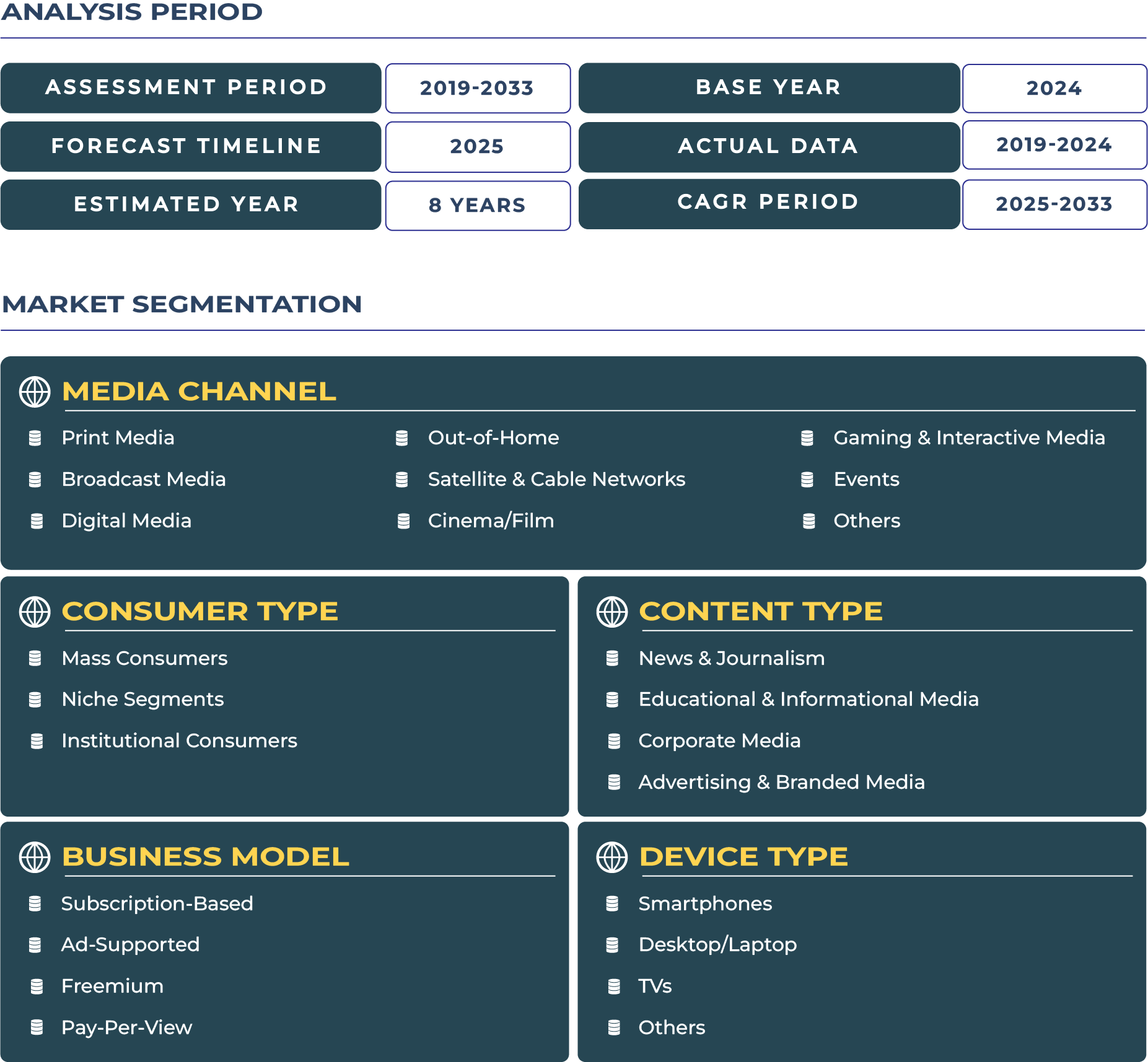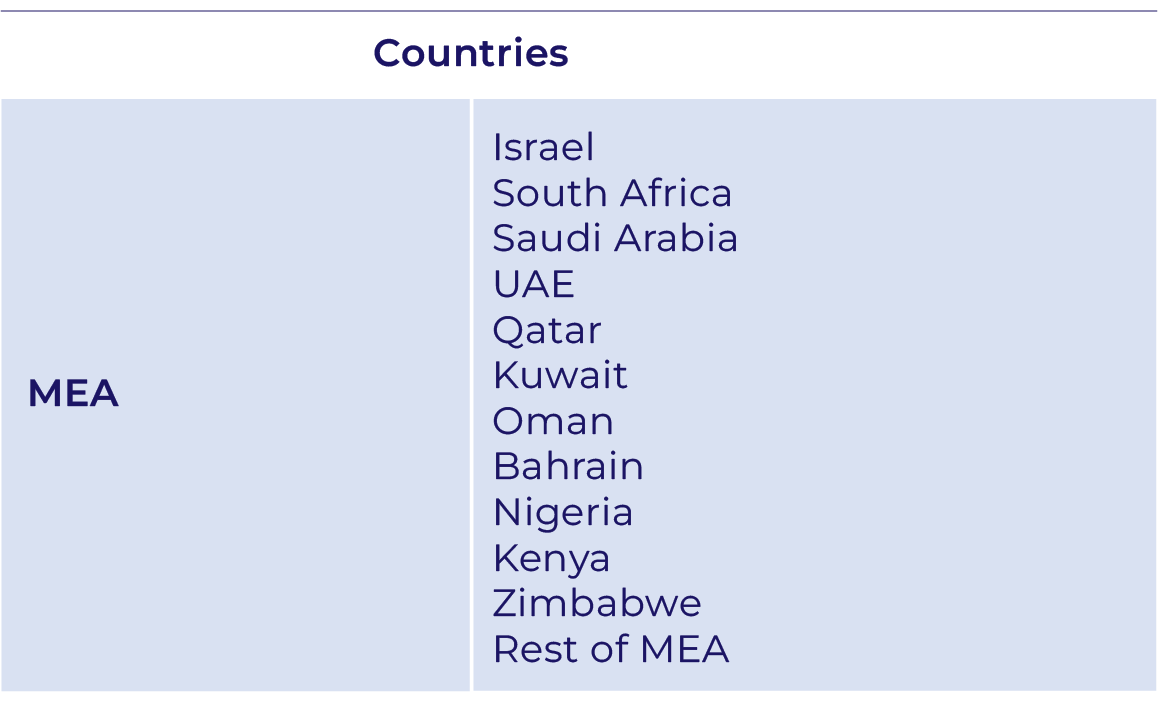MEA Media Market Outlook: The Digital Renaissance of MEA's Media Sector
The Middle East and Africa (MEA) region is undergoing a transformative shift in its media landscape, driven by rapid digitalization, evolving consumer behaviors, and proactive governmental policies. This metamorphosis is not just reshaping content consumption but also redefining the very fabric of media production and distribution across the region
Driving Forces: Catalysts of Media Evolution in MEA
Several pivotal factors are propelling the media industry's growth in the MEA region
- Digital Infrastructure and Connectivity: The proliferation of high-speed internet and mobile penetration has democratized access to digital content. For instance, Saudi Arabia boasts an internet penetration rate exceeding 98% in 2024, with over 90% smartphone ownership, facilitating seamless content consumption.
- Youthful Demographics: A significant portion of the MEA population comprises young, tech-savvy individuals. In South Africa, the median age is approximately 28.3 years, with the 18–35 age group driving the majority of online entertainment consumption.
- Government Initiatives and Investments: Governments across the region are actively investing in digital infrastructure and creating conducive environments for media growth. The UAE's establishment of free zones like Dubai Media City has attracted over 1,300 media companies, fostering innovation and collaboration.
Market Trends: The Shift Towards Digital and Localized Content
The MEA media market is witnessing several notable trends
- Rise of OTT Platforms: Over-the-top (OTT) streaming services are gaining significant traction. In Saudi Arabia, platforms like Shahid, operated by MBC Group, have become dominant players, offering a mix of local and international content.
- Localization of Content: There's a growing demand for culturally relevant content. In South Africa, local productions, including Afrikaans dramas and Zulu-language series, are outperforming international titles, reflecting a preference for content that resonates with local audiences.
- Integration of Emerging Technologies: The adoption of technologies like Augmented Reality (AR) and Virtual Reality (VR) is revolutionizing content delivery and advertising. Brands are leveraging these technologies to create immersive experiences, enhancing consumer engagement.
Regional Analysis: Country-Specific Insights
- Saudi Arabia: The Kingdom is experiencing explosive growth in its media industry, driven by high internet penetration and smartphone usage. The General Authority of Media Regulation (GAMR) has introduced frameworks to ensure advertising transparency and cultural sensitivity, leveling the playing field for both international and local players.
- United Arab Emirates (UAE): The UAE's media sector is characterized by diversification and innovation. Dubai Media City serves as a hub for media companies, while Abu Dhabi Media's ventures have expanded their reach across the Arab world. Government initiatives have attracted foreign investment, positioning the UAE as a regional leader in media and entertainment.
- South Africa: The country's media industry is witnessing a surge in localized content production. Streaming services like Showmax and Netflix are investing in South African stories, catering to a growing audience that values cultural relevance. The success of local genres like Amapiano and Gqom in music streaming platforms underscores this trend.
- Nigeria: Nigeria's media market is among the fastest-growing globally, with an X.6% CAGR projected through 2033. The growth is fueled by internet advertising, video games, OTT services, and music streaming. The country's vibrant youth population and increasing disposable income are key drivers.
- Kenya: Despite being a smaller market, Kenya's media industry is poised for significant growth, with a projected X.2% CAGR through 2033. Internet advertising and OTT services are leading the way, supported by stable internet connectivity and 5G adoption.
Government Regulations and Competitive Landscape
Regulatory frameworks across the MEA region are evolving to accommodate the rapidly changing media landscape
- Saudi Arabia: The General Authority of Media Regulation oversees content standards, ensuring alignment with cultural norms. Recent reforms have provided clarity for OTT platforms, fostering a more competitive environment.
- UAE: The establishment of entities like Mada Media Company reflects the government's proactive approach to managing advertising and media assets, promoting innovation and compliance.
- South Africa: The South African Broadcasting Corporation (SABC) is investing in diverse content formats across languages and cultures, aiming to enhance inclusivity and national identity.
Major players in the MEA media market include:
- MBC Group: A Saudi-based conglomerate operating over 19 free-to-air satellite TV channels and the Shahid streaming platform. MBC is majority-owned by the Saudi government's Public Investment Fund.
- Anghami: The first legal music streaming platform in the Arab world, offering a vast catalog of Arabic and international music. In 2024, OSN+ acquired a 55.45% stake in Anghami, signaling consolidation in the regional streaming market.
- Mahatat: A Kuwait-based company operating a video-on-demand platform, offering a mix of Bollywood films, locally produced content, and exclusive originals. Mahatat has partnered with major studios like Sony Pictures Television and Miramax.
Embracing the Future of Media in MEA
The Middle East and Africa's media landscape is at a pivotal juncture, characterized by rapid digital transformation, localized content production, and supportive governmental policies. As the region continues to embrace technological advancements and cater to evolving consumer preferences, stakeholders must remain agile and innovative to capitalize on emerging opportunities
Author: Joseph Gomes Y (Head – Media and Entertainment)
*Research Methodology: This report is based on DataCube’s proprietary 3-stage forecasting model, combining primary research, secondary data triangulation, and expert validation. [Learn more]








